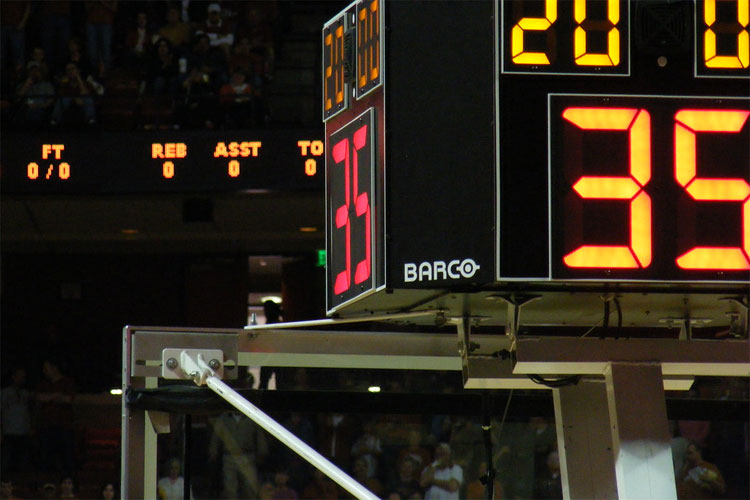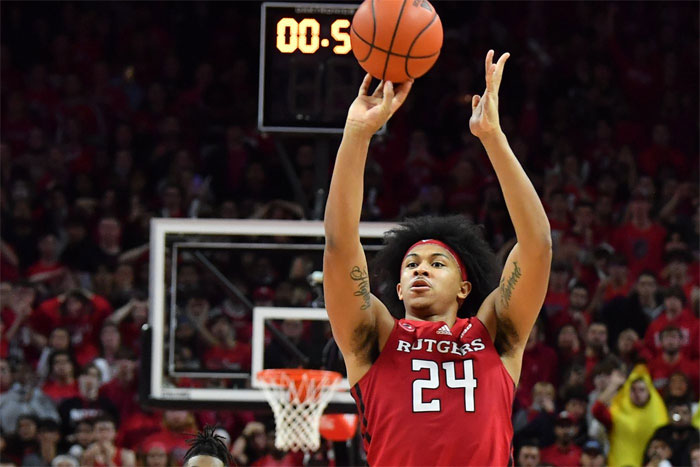The shot clock was first introduced in the NBA as far back as 1954. Today, it is an integral part of play. After all, no shot clock would mean no buzzer, and no buzzer means Michael Jordan couldn’t have graced us all with his epic game-winning buzzer-beaters.
The 24-second clock came into operation to encourage a faster pace in the game. It is always displayed to players and fans, usually right under the game clock. The shot clock forces players to make an attempt to score within a given time frame or risk losing possession.
Before adopting the shot clock, some teams could attempt to stall the match. Sometimes, you see this in soccer where the team with possession tries to hold on to the ball to waste time. This is common when the team with possession is up in goals and doesn’t want to risk their opponents scoring.
Basketball fans were eager for a more fast-paced sport. Thus the shot clock was born.
How the Shot Clock Works
Referees use the shot clock as a timing device to direct the pace of a basketball match. Think of it as a stopwatch that starts counting down when a team gains ball possession.
The clock ensures players take a shot or ball possession changes within the set timeframe. A referee blows a foul against the possessing team when this doesn't happen.
The shot clock must always be visible to all players on the court. For this reason, it is usually displayed above and right behind the backboard on both ends. Thus, players, coaches, and fans can all keep their eye on how many seconds are left.

The shot clock will always start with 24 seconds (except in cases of a 14-second clock). The clock will reset after a player takes a shot and either makes the basket or hits the rim when the opposing team gains possession due to a turnover or a rebound and whenever the referee blows the whistle.
In some cases, the shot clock is only set to 14 seconds instead of 24. This rule was adopted by the NBA in 2018 but has been standard in FIBA since 2014. The clock will be set to 14 seconds when an offensive team is fouled but is not awarded any free throws.
Sometimes, the ref will only allow an inbound pass and a shot clock reset. When this happens, the clock is only set to 14 seconds.
Shot Clock Violations
A violation occurs if the team with possession does not take a shot within 24 seconds. In other words, the offensive team must present an opportunity for the defensive team to take possession. However, in any case, the referee makes the final decision.
When a shot clock violation occurs, the referee temporarily suspends play for a few seconds. This allows the ball to change hands to the team that now wins possession. Then the game continues. The only penalty is a loss of possession.
Introducing the Shot Clock in Basketball
On November 22, 1950, the NBA recorded its shortest scoring game. This was the match between the Minneapolis Lakers and the Fort Wayne Pistons. The game ended at a depressing 18-19 scoreline. Interestingly, the referee recorded only four points during the fourth part of the game.
As you'd expect, the game was a bit boring to watch. As a result, some supporters were disappointed. Besides, this wasn't the only low-scoring game in the league.
The league officials were smart enough to see the adverse effects of such gameplay. Overall, fans didn't like watching slow games. So, they sought to make a change.
In the early 1950s, the NBA experimented with several rule revisions. They aimed to speed up the game and minimize fouls. Eventually, they settled for the shot clock method.
Undoubtedly, the shot clock rules have been tweaked slightly over the years. However, the concept has remained the same and has served as an effective way to encourage more intense gameplay.
Why Is the Shot Clock 24 Seconds?
Interestingly, Danny Biasone scribbled the 24-second shot clock formula on a napkin. This happened at his bowling alley in Eastwood, Syracuse. Once upon a time, Danny Biasone was the owner of the New York Syracuse Nationals basketball team. Today, we know them as the Philadelphia 76ers.
Danny didn't like watching slow games, and he resolved to find the secret to increasing his enjoyment from watching basketball.
According to him, he based the 24-second shot clock on the games that he enjoyed watching most. He noticed that the fun games to watch saw that each team took at least 60 shots, which amounted to 120 shots per game.
Back then, a standard basketball game was 48 minutes. All Danny did was divide 2,880 seconds (48 minutes) by 120 to find that a shot should be attempted every 24 seconds.
How Players and Fans Reacted
Danny first convinced the NBA to introduce the shot clock for the 1954-55 season. The first game monitored using Danny's clock was confusing as players couldn't quite grasp what to do.
As a result, they were frantically shooting hoops in less than 20 seconds. They thought taking quick shots was the best thing to do. It took some time before they adjusted to utilize the full 24 seconds to make a good play.

But the shot clock wasn't perfect. The NBA had to change some rules to incorporate it more smoothly. However, once they did, the average points per game increased to 79. Nowadays, teams average about 112 points per game.
Unsurprisingly, the increase in points per game attracted more viewers to the NBA. Within a few years of adopting the shot clock, attendance increased by over 39%, and spectatorship grew to 4,500 people per game.
Shot Clocks in Different Leagues
The NBA has been consistent with the 24-second possession rule for over 60 years. Ultimately, the shot clock has not undergone any significant modification since its introduction. However, the rule is not the same in other leagues.
College Basketball
Referees have used the shot clock at the college level for forty years. However, they have modified its use in some ways.
After a successful trial run during conferences, the board implemented the 45-second shot clock. They tested the new rule at the collegiate level for the 1985-86 season.
Also, the NCAA was undergoing significant change during this period. They introduced the three-point shot the following year. The aim was to make their game more exciting.
Afterward, the regulators reduced the NCAA basketball shot clock. The duration went from 45-seconds to 35-seconds for the 1993-94 season. The college board made this decision because they did not get the expected results.
However, the NCAA used this rule for more than two decades until they finally adjusted it again. As of 2015, the shot clock is 30 seconds.
High School Basketball
The National Federation of State High School Associations (NFHS) makes rules for high school basketball in the US. The body does not require the use of a shot clock. Instead, they allow each state association to decide whether or not to use one and for how long.
Over the years, some high schools have adopted the 35-second shot clock. Most recently, Minnesota State High School moved to introduce a 35-second clock. The board of directors approved the decision. So, starting in the 2023-24 season, the MSHSL will implement shot clocks. This will apply to both the boys' and the girls' varsity games.
Conclusion: Shot Clock Basketball
Shot clocks play a role in various sports, including water polo and lacrosse. In basketball, the advent of the shot clock drastically changed the game.
The shot clock is a 24-second timer that dictates possession. The offensive team must make a play within the timeframe, or they lose possession. A shot clock violation does not carry any other heavy penalties.
By introducing the shot clock and the rules associated with it, the NBA soared in popularity. They were able to increase interest in basketball as well as attendance at games and TV viewership. The shot clock increased the drama of the game and made it more exciting to watch.
You might also like: What is a Clutch in Basketball?
